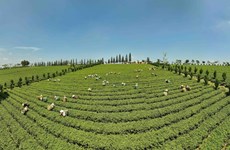Wood industry urged to target local market
A wood export revenue target for 2011 of around 4 billion USD is quite
achievable, however, exporters are being advised to focus more on
growing domestic demand in order to avoid the risk of rising input
prices.
A wood export revenue target for 2011 of around 4 billion USD is quite
achievable, however, exporters are being advised to focus more on
growing domestic demand in order to avoid the risk of rising input
prices.
The Handicraft and Wood Industry Association of HCM City (HAWA) statistics showed that Vietnam ranked fourth among Southeast Asia's wood exporters, but just 20 percent of the wood products consumed in the country are produced by Vietnamese enterprises, the remaining 80 are imported from mainland China, Hong Kong, Thailand and Taiwan.
"While export market is being successfully exploited, the domestic market has been left wide open," Nguyen Chien Thang, HAWA's chairman said.
HAWA stated that domestic consumer demand is estimated to increase by an average 15 percent per annum. Demand for wood products for high-end apartments in HCM City and Hanoi totals hundreds of millions of dollars every year.
"Vietnamese enterprises should be more familiar with domestic consumer tastes. If there is a focus on high to average income segments, they can definitely dominate the domestic market, instead of wrestling over foreign markets," Thang said.
Ngo Thi Hong Thu, deputy director of wood processor Truong Thanh Co suggested that Vietnamese wood processors should shift 30-50 percent of the products they export onto the domestic market to minimise risks in the global market as well as to diversify consumer wood goods.
Advice to concentrate more on the domestic market is based on the increased challenges posed to maintain market share in the US, Europe and Japan as price and tariffs begin to take their toll.
The Vietnam Timber and Forest Product Association's (Vifores) Secretary General Nguyen Ton Quyen said that the biggest headache for produces now is rising input costs.
To have wood to process for exports, Viet Nam has to pay an average of 1 billion USD for 3 million cubic metres of raw material every year. In 2010 alone, expenditure for raw materials stood at 900 million USD. Domestic raw material supplies meet just 20 percent of the demand.
The price of rubber wood rose by 50 - 60 percent compared to last year, while prices of paints and other materials have also increased 20 percent from last year.
Increased input costs are likely to push up the prices of completed products, which will lower the competitiveness of made-in-Vietnam wood products on global market.
A survey recently conducted by HAWA shows that despite rising costs, some processors will accept lower selling prices to win orders from foreign importers.
Thu admitted that despite the company having received orders equivalent to an estimated 70 percent of output for the whole year, the biggest challenge now is cost.
"Rising and fast changing input costs have caused many difficulties for the business," she said.
"Higher material costs could have been resolved by increased stockpiling of inputs, but it is impossible now given high interest rates and rapid changes in consumer tastes," she added.
Some companies have accepted low profit margins or break-even prices to maintain customers and preserve jobs, the association said.
The US and European countries have recently imposed Lacey and Flegt Acts to tighten criteria against wood imports.
Francesco Russo, chief technical advisor of a United Nations Industrial Development Organisation (UNIDO) project on small and medium sized enterprises cluster development said that to deal with the new legislation, Vietnamese wood processors needed firm connections and more efficient production, otherwise they will not be able to control input material quality and prices.
"So, to some extent, domestic enterprises should think of targeting the domestic market," Dang Quoc Hung, HAWA's vice chairman said./.
The Handicraft and Wood Industry Association of HCM City (HAWA) statistics showed that Vietnam ranked fourth among Southeast Asia's wood exporters, but just 20 percent of the wood products consumed in the country are produced by Vietnamese enterprises, the remaining 80 are imported from mainland China, Hong Kong, Thailand and Taiwan.
"While export market is being successfully exploited, the domestic market has been left wide open," Nguyen Chien Thang, HAWA's chairman said.
HAWA stated that domestic consumer demand is estimated to increase by an average 15 percent per annum. Demand for wood products for high-end apartments in HCM City and Hanoi totals hundreds of millions of dollars every year.
"Vietnamese enterprises should be more familiar with domestic consumer tastes. If there is a focus on high to average income segments, they can definitely dominate the domestic market, instead of wrestling over foreign markets," Thang said.
Ngo Thi Hong Thu, deputy director of wood processor Truong Thanh Co suggested that Vietnamese wood processors should shift 30-50 percent of the products they export onto the domestic market to minimise risks in the global market as well as to diversify consumer wood goods.
Advice to concentrate more on the domestic market is based on the increased challenges posed to maintain market share in the US, Europe and Japan as price and tariffs begin to take their toll.
The Vietnam Timber and Forest Product Association's (Vifores) Secretary General Nguyen Ton Quyen said that the biggest headache for produces now is rising input costs.
To have wood to process for exports, Viet Nam has to pay an average of 1 billion USD for 3 million cubic metres of raw material every year. In 2010 alone, expenditure for raw materials stood at 900 million USD. Domestic raw material supplies meet just 20 percent of the demand.
The price of rubber wood rose by 50 - 60 percent compared to last year, while prices of paints and other materials have also increased 20 percent from last year.
Increased input costs are likely to push up the prices of completed products, which will lower the competitiveness of made-in-Vietnam wood products on global market.
A survey recently conducted by HAWA shows that despite rising costs, some processors will accept lower selling prices to win orders from foreign importers.
Thu admitted that despite the company having received orders equivalent to an estimated 70 percent of output for the whole year, the biggest challenge now is cost.
"Rising and fast changing input costs have caused many difficulties for the business," she said.
"Higher material costs could have been resolved by increased stockpiling of inputs, but it is impossible now given high interest rates and rapid changes in consumer tastes," she added.
Some companies have accepted low profit margins or break-even prices to maintain customers and preserve jobs, the association said.
The US and European countries have recently imposed Lacey and Flegt Acts to tighten criteria against wood imports.
Francesco Russo, chief technical advisor of a United Nations Industrial Development Organisation (UNIDO) project on small and medium sized enterprises cluster development said that to deal with the new legislation, Vietnamese wood processors needed firm connections and more efficient production, otherwise they will not be able to control input material quality and prices.
"So, to some extent, domestic enterprises should think of targeting the domestic market," Dang Quoc Hung, HAWA's vice chairman said./.












